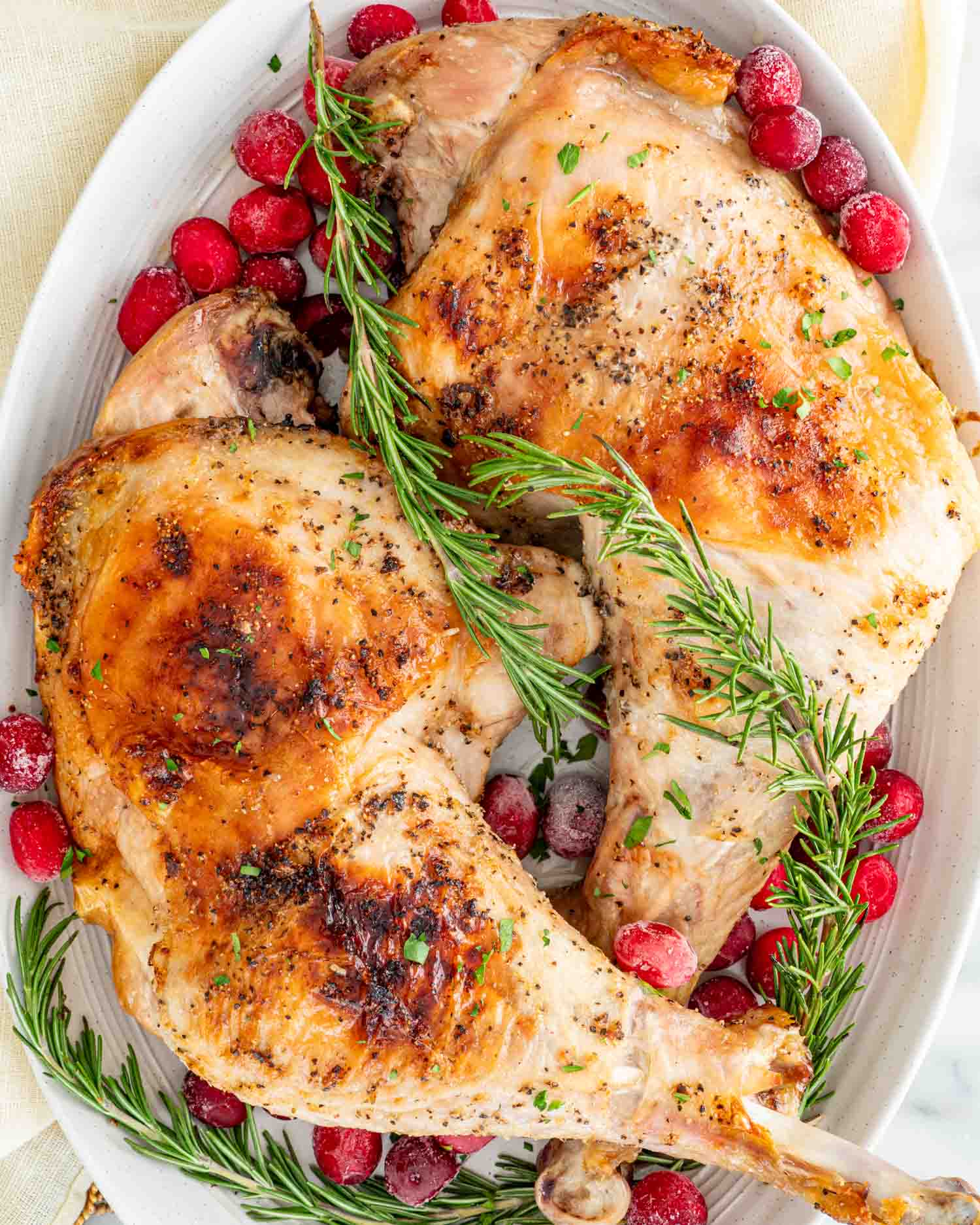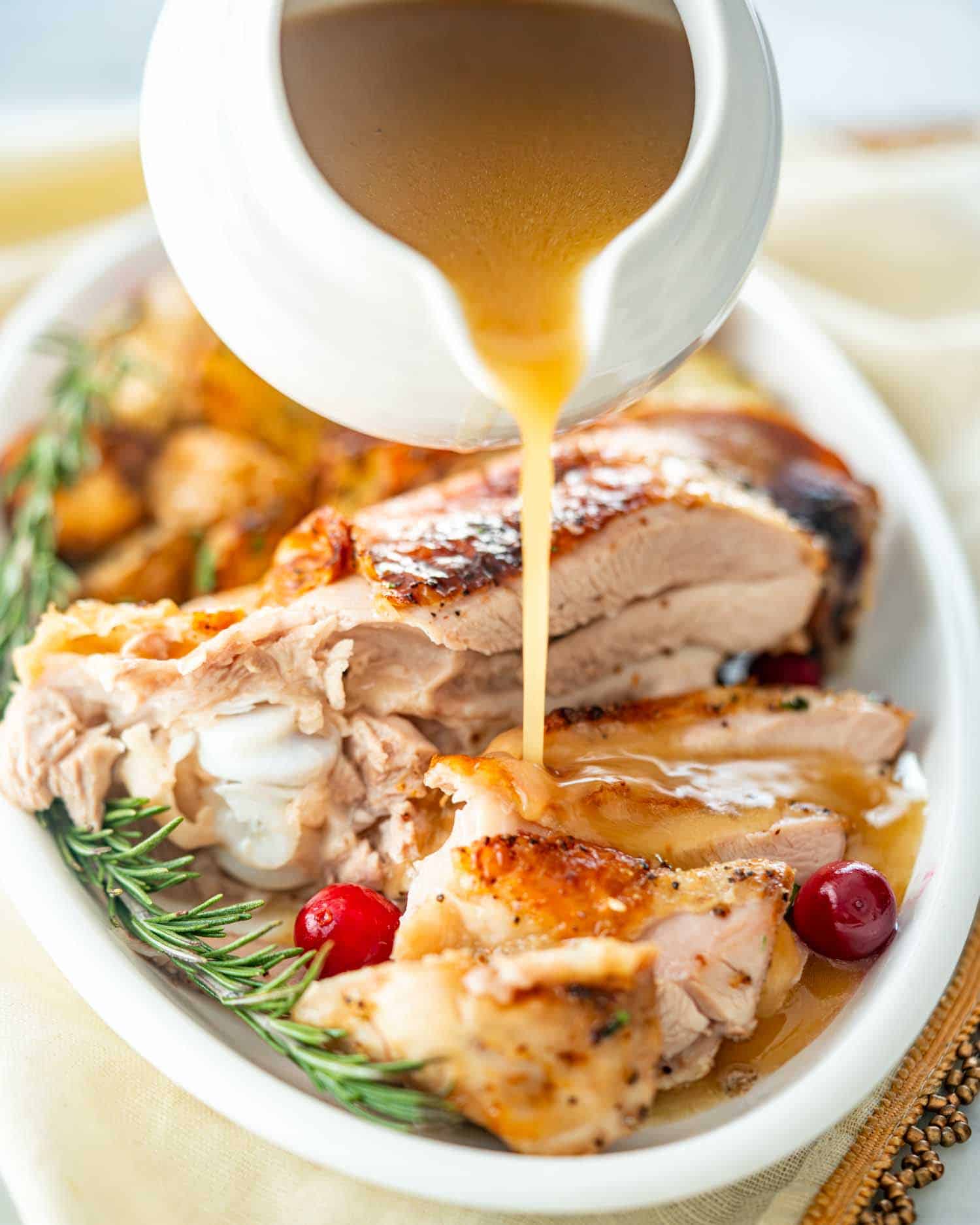These Easy Roasted Turkey Legs are the perfect alternative to roasting an entire turkey! Made with only 3 simple ingredients, this recipe is no fuss, no muss and there’s no tricky carving required!
Turkey legs and thighs are often considered the best parts of the bird, prized for their rich, savory dark meat. They make a nice change from the usual chicken dinner. While you can roast a whole turkey just for the legs and thighs, it’s often easier to purchase them separately. Here’s how to cook turkey legs and thighs so they turn out juicy, tender and full of flavor every time.
Selecting Turkey Legs and Thighs
When selecting turkey legs and thighs, look for pieces that are broad and plump, which indicates more meat. The skin should be smooth and creamy white. Avoid pieces with tears or blemishes on the skin.
Turkey parts are sold fresh or frozen. For the most flavor and juiciness, fresh is ideal. However frozen turkey legs and thighs can also be quite tasty if thawed properly.
Turkey legs are the drumsticks of the bird. The meatiest part is at the top near the thigh. Turkey thighs are darker than breast meat but not as dark as the legs. They have more fat marbling than breast meat, which keeps them moist during cooking.
When choosing turkey thighs opt for bone-in since the bone adds flavor. Boneless thighs tend to dry out more easily. For even cooking, choose thighs that are similar in size.
Thawing Frozen Turkey Parts
Always thaw frozen turkey legs and thighs in the refrigerator, not at room temperature. This prevents bacterial growth. Figure on 24 hours of thawing time per pound.
Place the frozen turkey in a pan to catch any juices that leak during thawing. Use the turkey within 1-2 days after it has thawed.
You can also submerge a sealed bag of frozen turkey in cold water. Change the water every 30 minutes until thawed. Cook immediately after thawing this way.
Seasoning turkey legs and thighs
Seasoning is key for flavorful turkey legs and thighs. This can be done with a simple dry rub or brine.
Dry rub
A dry rub adds lots of flavor and is easy to make. Combine seasonings like garlic powder, onion powder, paprika, dried thyme, salt and pepper. Pat the mixture evenly all over the turkey pieces. Cover and refrigerate 8 hours up to 2 days.
Wet brine
Soaking turkey in a saltwater solution or broth draws out blood and impurities while helping it retain moisture. Dissolve 1/2 cup salt in 4 cups water or broth and submerge turkey pieces for 2-6 hours in the fridge. Rinse and pat dry before cooking.
Marinade
For added flavor, marinate turkey thighs and legs in a blend of olive oil, citrus juice, garlic, and herbs for at least 2 hours before cooking.
Roasting Turkey Legs and Thighs
Roasting is one of the easiest ways to cook turkey legs and thighs. It results in moist, tender meat and crisp, browned skin.
-
Preheat oven to 350°F. Pat turkey pieces dry and place in a single layer in a roasting pan or rimmed baking sheet.
-
Brush skin lightly with olive oil or melted butter. Season generously with salt, pepper and any other spices desired.
-
Roast 40-60 minutes, until the juices run clear and an instant-read thermometer inserted in the thickest part reads 165°F for white meat, 175°F for dark meat.
-
Let rest 10 minutes before carving. The temperature will rise about 5°F as it rests.
Grilling Turkey Legs and Thighs
Grilling imparts delicious smoky barbecue flavor. It works best for turkey legs, which can cook evenly over direct heat. Thighs are prone to drying out on the grill, so indirect heat is best.
-
Prepare a two-zone fire, with one side hot and the other low/medium heat.
-
Grill thighs over indirect heat with the lid closed as much as possible, until 165°F, up to 1 hour.
-
Grill legs over direct heat, turning occasionally until 175°F, about 40 minutes.
-
Brush with barbecue sauce during last 10 minutes if desired.
Baking Turkey Drumsticks
Baked turkey drumsticks make for a fun, hand-held meal. The dry heat of the oven ensures a crispy skin.
-
Preheat oven to 375°F. Place drumsticks in a baking dish just large enough to hold them.
-
Brush with oil and season with a poultry seasoning blend.
-
Bake 45-60 minutes until 175°F.
-
For crispier skin, broil 3-5 minutes at the end.
Sous Vide Turkey Thighs
The sous vide cooking method results in exceptionally tender, juicy turkey thighs. Vacuum-sealed thighs are cooked for 1-2 hours in a precisely temperature controlled water bath.
-
Season turkey thighs with salt, pepper and thyme. Seal in bags and submerge in 165°F water for 1 hour.
-
Remove thighs from bags and pat dry. Quickly sear skin side down in an oiled skillet until crisp.
Simmering Turkey Legs in Soup
Simmering turkey legs in broth or soup is a great way to infuse flavor. The meat becomes fall-off-the-bone tender.
-
In a large pot, combine 8 cups chicken or turkey broth, turkey legs, carrots, celery, onion, garlic, and seasonings.
-
Bring to a simmer, then reduce heat and cook gently until turkey is tender, 60-90 minutes.
-
Remove turkey legs, cool slightly and cut or shred meat before adding back to soup.
-
Simmer another 15 minutes before serving.
Deep Frying Turkey Pieces
Deep fried turkey legs and thighs are crispy on the outside while remaining incredibly moist inside. Use a deep fryer with a basket to carefully lower turkey into hot oil.
-
Heat at least 4 inches of peanut or canola oil to 350°F in a deep fryer or heavy pot.
-
Pat turkey pieces dry. Season lightly with salt and pepper.
-
Fry turkey thighs about 4-5 minutes, legs 6-8 minutes until 175°F internally. Drain on a paper towel-lined rack.
Common Mistakes to Avoid
Avoid these common mistakes when cooking turkey legs and thighs:
-
Undercooking – Use a meat thermometer to ensure the minimum safe temperature is reached.
-
Overcooking – This leads to dry, tough meat. Stop roasting at 175°F.
-
Uneven cooking – Arrange thighs and legs in a single layer with space between to allow air flow.
-
Skipping brining/seasoning – This results in bland, flavorless meat.
-
Burning the skin – Use lower heat for crispy skin without burning.
-
Letting sit too long after cooking – Eat turkey right after the recommended resting time.
Serving Suggestions
Here are some delicious ways to serve your cooked turkey legs and thighs:
-
Pair with classic Thanksgiving sides like mashed potatoes, stuffing and gravy.
-
Serve with roasted vegetables like Brussels sprouts, carrots and parsnips.
-
Make turkey sandwiches and wraps with cranberry sauce.
-
Dice or shred turkey meat for casseroles, soups and chili.
-
Pile sliced turkey onto salad greens for a hearty main-dish salad.
-
Stuff cooked diced turkey into an omelet or frittata.
So for moist, juicy turkey with crispy browned skin, try these tips for cooking legs and thighs. Just be sure to properly season and avoid overcooking. What are your favorite ways to serve turkey parts?
:max_bytes(150000):strip_icc()/turkey-legs-recipe-49f63a372a8444af86683ae20e285c1a.jpg)
How Do I Know When My Turkey Legs Are Done?
I’ve said it before and I’ll say it again! The best way to know when your turkey is cooked, is with an instant meat thermometer! When the internal temperature of the thighs reaches 170°F, it’s done. Each oven is different, so keep in mind it can take longer or less time than specified.
Using Smaller Turkey Legs?
Depending on the size of your turkey legs, cook times may vary. Each of my turkey legs were over 2 lbs so they took a bit longer to cook. If your turkey legs are smaller in size, they may take less time. Start checking the temperature after 1 hour.
Whether it’s Thanksgiving, Christmas, or Easter, these roasted turkey legs are a great option for a small dinner. This recipe makes about 6 servings, so choose your favorite sides, turkey gravy and enjoy!

- Get an instant meat thermometer! It is a life saver when it comes to cooking not only turkey, but any kind of meat.
- Feel free to play around with spices, sauces and herbs. If you’re looking for a flavorful, liquid gold sauce, check out my maple mustard turkey thighs.
- You can always cook more turkey legs if looking to serve more people.
Store leftover roasted turkey legs in an airtight container in the refrigerator for 3-5 days.
You can also freeze your turkey legs! Stored in airtight container, they will last for 3 months frozen!

How to Cook Wild Turkey Legs!
FAQ
What temperature should a turkey leg be cooked at?
How do you keep turkey legs from drying out?
What temperature should turkey thigh be cooked to?
What is the difference between a turkey leg and thigh?
